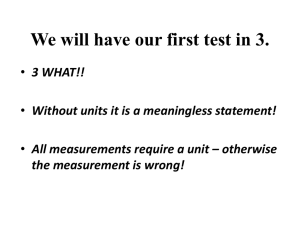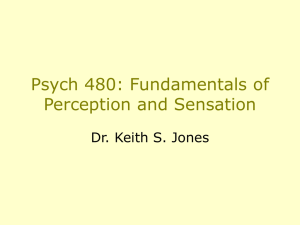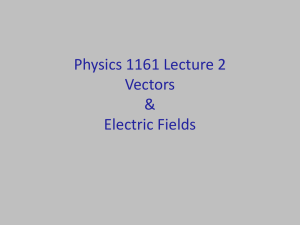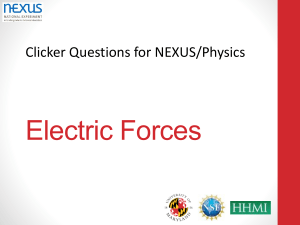Local phase - Oklahoma State University
advertisement
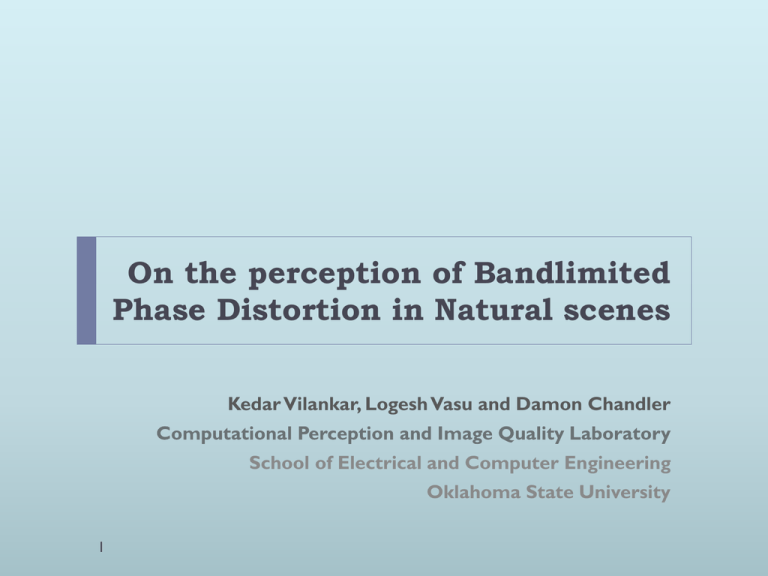
On the perception of Bandlimited Phase Distortion in Natural scenes Kedar Vilankar, Logesh Vasu and Damon Chandler School of Electrical and Computer Engineering Oklahoma State University 1 Importance of Phase Oppenheim and Lim (1981) demonstrated the importance of phase in signals. Magnitude Spectrum Phase Spectrum Phase spectrum contributes more to the image’s visual appearance. 2 of 51 Cells Compute Local Information Primates V1 is dominated by complex cells. V1 complex cells are insensitive to phase V1 complex cells encode the magnitude information only. V1 complex cells are localized to receptive fields. 3 of 51 Local Magnitude is all we need Phase information is implicitly encoded in local magnitude. Morrone and Burr demonstrated computation of location of lines and edges (Phase congruency) from local magnitude (Complex cell response). Also, other researchers have shown only local magnitude is required for scene recognition and categorization. 4 of 51 Local Magnitude is all we need Morgan et. al demonstrated local phase is of lesser importance than local magnitude. Magnitude uses Spectrum local magnitude Phase information to Spectrum HVS global (image-wide) phase information. 5 of 51 determine Does HVS use Local Phase ? Signal processing perspective, local phase is important. If HVS uses only local magnitude, then we should not see any impact of distortion in local phase. Local Phase Original Distorted Image Image 6 of 51 Does HVS use Local Phase ? Complex cells compute local magnitude by combining the responses of two simple cells. May also exist a visual mechanism to compute local phase using simple cells. 7 of 51 Does HVS use Local Phase ? If HVS has mechanism to compute local phase, then do we infer global phase from 1. only local magnitude or 2. both local magnitude and local phase 8 of 51 Summary Global phase is most important for image appearance. (Oppenheim & Lim) Local magnitude can implicitly encode global phase. (Morrone et al. and Shams et al.) Local phase is of lesser importance for image appearance However, local phase distortion has substantial impact on image quality. 9 of 51 Outline Experiment (Local Phase Contribution) Results (Interesting and surprising) Discussion (Open questions. We need help) Algorithm (Local magnitude and phase Distortion Rater) Conclusion (Our belief) 10 of 51 Experiment Measure the relative contribution of local magnitude and local phase towards image appearance. Stimuli were created by forming hybrid in complex wavelet subbands. Each subbands local magnitude and local phase was taken from 2- 4 original images. 11 of 51 Experiment Local Magnitude Local Phase Low Frequency 12 of 51 High Frequency Original Images Frequency (cyc/deg) Experiment Local Magnitude Local Phase Low Frequency 13 of 51 High Frequency Original Images Frequency (cyc/deg) Experiment Based on permutations to make hybrid images 14 combination were created. For each combination 12 stimuli were created. Five subjects were asked to rate how much each original image contribute to the appearance of the stimulus. Viewing distance : 60cm. Five choices : 5%, 10%, 25%, 50% and 75% 14 of 51 Result : Combination 1 Local Magnitude Local Phase Low Frequency 15 of 51 High Frequency Original Images Frequency (cyc/deg) Result : Combination 1 Local Magnitude Local Phase Low Frequency 16 of 51 High Frequency Original Images Stimulus Frequency (cyc/deg) Result : Combination 1 59% Local Magnitude 6% Local Phase 8% Low Frequency 17 of 51 27% High Frequency Frequency (cyc/deg) Stimulus Original Images Result : Combination 1 59% Local Magnitude 6% Local Phase 27% 8% Low Frequency High Frequency Frequency (cyc/deg) Stimulus When across frequencies, local magnitude and phase have non cooperative information, then HVS relies mostly on high frequency local magnitude information. Original Images 18 Result : Combination 3 Local Magnitude Local Phase Low Frequency 19 of 51 High Frequency Original Images Frequency (cyc/deg) Result : Combination 3 Local Magnitude Local Phase Low Frequency 20 of 51 High Frequency Original Images Stimulus Frequency (cyc/deg) Result : Combination 3 39% Local Magnitude 6% 55% Local Phase Low Frequency 21 of 51 High Frequency Frequency (cyc/deg) Stimulus Original Images Result : Combination 3 39% Local Magnitude 6% 55% Local Phase Low Frequency High Frequency Frequency (cyc/deg) Stimulus When local phase across entire frequency channels cooperate, then local phase information dominates local magnitude information. Original Images 22 Result : Combination 12 Local Magnitude Local Phase Low Frequency 23 of 51 High Frequency Original Images Frequency (cyc/deg) Result : Combination 12 Local Magnitude Local Phase Low Frequency 24 of 51 High Frequency Original Images Stimulus Frequency (cyc/deg) Result : Combination 12 48% Local Magnitude 52% Local Phase Low Frequency 25 of 51 High Frequency Frequency (cyc/deg) Stimulus Original Images Result : Combination 12 48% Local Magnitude 52% Local Phase Low Frequency High Frequency Frequency (cyc/deg) Stimulus Local phase and local magnitude have equal importance for the appearance of an image 26 of 51 Original Images Result : Combination 13 Local Magnitude Local Phase Low Frequency 27 of 51 High Frequency Original Images Frequency (cyc/deg) Result : Combination 13 Local Magnitude Local Phase Low Frequency 28 of 51 High Frequency Original Images Stimulus Frequency (cyc/deg) Result : Combination 13 76% Local Magnitude 24% Local Phase Low Frequency 29 of 51 High Frequency Frequency (cyc/deg) Stimulus Original Images Result : Combination 13 76% Local Magnitude 24% Local Phase Low Frequency High Frequency Frequency (cyc/deg) Stimulus High frequency information is more important than low frequency for image appearance. 30 of 51 Original Images Discussion Do we infer global phase from local phase? 31 of 51 Result : Combination 12 48% Local Magnitude 52% Local Phase Low Frequency 32 of 51 High Frequency Frequency (cyc/deg) Stimulus Original Images Discussion Is there visual summation of local phase across frequency channels? 33 of 51 Result : Combination 3 39% Local Magnitude 6% 55% Local Phase Low Frequency 34 of 51 High Frequency Frequency (cyc/deg) Stimulus Original Images Discussion Why HVS needs local phase information? 35 of 51 Discussion How local phase is computed in HVS? 36 of 51 Discussion What is the neural basis for this computation? 37 of 51 Discussion What is more important low frequency or high frequency? 38 of 51 Result : Combination 13 76% Local Magnitude 24% Local Phase Low Frequency 39 of 51 High Frequency Frequency (cyc/deg) Stimulus Original Images Discussion What is more important low frequency or high frequency? Previous research: Low and high convey independent information about image structure For categorization task 1. 2. Between class – Low frequency Within class – High frequency Information content in low and high frequency. Is this task dependent? 40 of 51 Algorithm LMPD Local Magnitude and Phase Distortion Rater Algorithm was developed to rate the quality of local phase distorted images using experimental results. Algorithm computes local phase as well as local magnitude distortions in an image. 41 of 51 Algorithm LMPD Local Magnitude and Phase Distortion Rater Local Magnitude distortion Decompose original and distorted images in five scale and ten orientation log-Gabor subbands. For each scale 1. 2. a. b. c. d. e. 42 of 51 Compute local energy maps of the original and distorted images. Compute local MSE map between local energy maps of the original and distorted images. Use block size of 16 × 16 for local MSE. Collapse local MSE map via the L2 − norm into a single scalar value. Compute correlation between local energy maps of original and distorted images. Compute local magnitude distortion Si(where, i is the index for current scale) by multiplying scalar values obtained in step (c) and (d). Algorithm LMPD Local Magnitude and Phase Distortion Rater 3. Using Equation combine the local magnitude distortion obtained for each scale in step (e) to compute local magnitude distortion rating in the distorted image. localmagnitudeDistortionRating = (𝑠1𝑝1 ) + (𝑠2𝑝2 ) + (𝑠3𝑝3 ) + (𝑠4𝑝4 ) + (𝑠5𝑝5 ) 𝑝1, 𝑝2, 𝑝3, 𝑝4, 𝑝5 are power coefficients with values of 4, 4, 2, 1.5 and 0.143 respectively 43 of 51 Algorithm LMPD Local Magnitude and Phase Distortion Rater Local phase distortion 1. Decompose original and distorted images in four levels and four orientation complex wavelet subbands. 2. For each level of the complex wavelet subband a. b. 44 of 51 Extract local phase information of the original and distorted image. Compute local phase distortion E (where, i is the index for current level) by computing MSE between local phase of the original and distorted image obtained in step (a). i Algorithm LMPD Local Magnitude and Phase Distortion Rater 3. Using Equation combine the local Phase distortion obtained for each scale in step (b) to compute local phase distortion rating in the distorted image. localphaseDistortionRating = (𝐸1𝑝1 ) + (𝐸2𝑝2 ) + (𝐸3𝑝3 ) + (𝐸4𝑝4 ) 𝑝1, 𝑝2, 𝑝3, 𝑝4are power coefficients with values of 2.1, 2.4, 2.3, and 2.2 respectively 45 of 51 Algorithm LMPD Local Magnitude and Phase Distortion Rater Final quality rating of distorted image 𝐿𝑀𝑃𝐷 = localmagnitudeDistortionRatingα × localphaseDistortionRating(1−α) α = 0.6 46 of 51 Algorithm LMPD Local Magnitude and Phase Distortion Rater Database of 48 phase distorted images. Five subjects rated the distorted images. Performance of LMPD compared with other image quality assessment algorithms. 47 of 51 Algorithm LMPD Local Magnitude and Phase Distortion Rater Database of 48 phase distorted images. Five subjects rated the distorted images. Performance of LMPD compared with other image quality assessment algorithms. Correlation 48 of 51 PSNR SSIM CWSSI M NQM VIF MAD LMPD 0.387 0.531 0.458 0.424 0.580 0.281 0.708 Conclusion Local magnitude is most important information for image appearance. Local phase also has a substantial, sometimes dominating contribution. Local phase distortion of the images also has a substantial effect on image quality. 49 of 51 Conclusion We believe that an explicit mechanism does exist in visual cortex for the computation of local phase information. 50 of 51 Thank You Questions? For more stimuli examples please visit http://vision.okstate.edu/localphase/ 51 of 51


